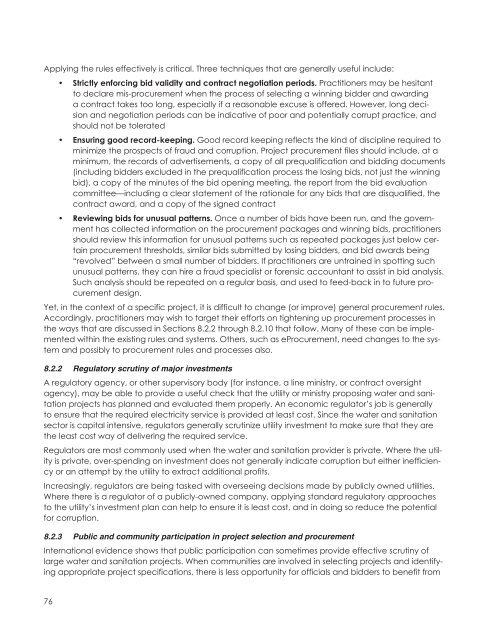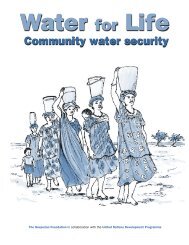A Sourcebook - UN-Water
A Sourcebook - UN-Water
A Sourcebook - UN-Water
Create successful ePaper yourself
Turn your PDF publications into a flip-book with our unique Google optimized e-Paper software.
Applying the rules effectively is critical. Three techniques that are generally useful include:<br />
• Strictly enforcing bid validity and contract negotiation periods. Practitioners may be hesitant<br />
to declare mis-procurement when the process of selecting a winning bidder and awarding<br />
a contract takes too long, especially if a reasonable excuse is offered. However, long decision<br />
and negotiation periods can be indicative of poor and potentially corrupt practice, and<br />
should not be tolerated<br />
• E nsuring good record-keeping. Good record keeping reflects the kind of discipline required to<br />
minimize the prospects of fraud and corruption. Project procurement files should include, at a<br />
minimum, the records of advertisements, a copy of all prequalification and bidding documents<br />
(including bidders excluded in the prequalification process the losing bids, not just the winning<br />
bid), a copy of the minutes of the bid opening meeting, the report from the bid evaluation<br />
committee—including a clear statement of the rationale for any bids that are disqualified, the<br />
contract award, and a copy of the signed contract<br />
• R eviewing bids for unusual patterns. Once a number of bids have been run, and the government<br />
has collected information on the procurement packages and winning bids, practitioners<br />
should review this information for unusual patterns such as repeated packages just below certain<br />
procurement thresholds, similar bids submitted by losing bidders, and bid awards being<br />
“revolved” between a small number of bidders. If practitioners are untrained in spotting such<br />
unusual patterns, they can hire a fraud specialist or forensic accountant to assist in bid analysis.<br />
Such analysis should be repeated on a regular basis, and used to feed-back in to future procurement<br />
design.<br />
Yet, in the context of a specific project, it is difficult to change (or improve) general procurement rules.<br />
Accordingly, practitioners may wish to target their efforts on tightening up procurement processes in<br />
the ways that are discussed in Sections 8.2.2 through 8.2.10 that follow. Many of these can be implemented<br />
within the existing rules and systems. Others, such as eProcurement, need changes to the system<br />
and possibly to procurement rules and processes also.<br />
8.2.2 Regulatory scrutiny of major investments<br />
A regulatory agency, or other supervisory body (for instance, a line ministry, or contract oversight<br />
agency), may be able to provide a useful check that the utility or ministry proposing water and sanitation<br />
projects has planned and evaluated them properly. An economic regulator’s job is generally<br />
to ensure that the required electricity service is provided at least cost. Since the water and sanitation<br />
sector is capital intensive, regulators generally scrutinize utility investment to make sure that they are<br />
the least cost way of delivering the required service.<br />
Regulators are most commonly used when the water and sanitation provider is private. Where the utility<br />
is private, over-spending on investment does not generally indicate corruption but either inefficiency<br />
or an attempt by the utility to extract additional profits.<br />
Increasingly, regulators are being tasked with overseeing decisions made by publicly owned utilities.<br />
Where there is a regulator of a publicly-owned company, applying standard regulatory approaches<br />
to the utility’s investment plan can help to ensure it is least cost, and in doing so reduce the potential<br />
for corruption.<br />
8.2.3 Public and community participation in project selection and procurement<br />
International evidence shows that public participation can sometimes provide effective scrutiny of<br />
large water and sanitation projects. When communities are involved in selecting projects and identifying<br />
appropriate project specifications, there is less opportunity for officials and bidders to benefit from<br />
76
















